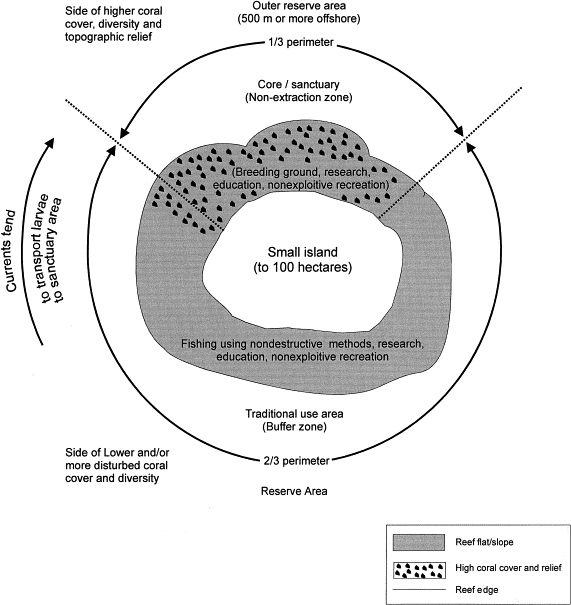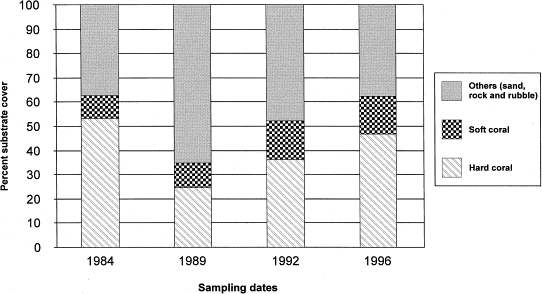CommunityManagement
Community-based Reef Management
Introduction:
- Community Management
“Community management is the management of a common resource or issue by a community through the collective action of volunteers and stakeholders.” Cite error: Invalid <ref> tag; refs with no name must have content
Community managment is important because without implementation, "a community's material resources may be depleted or rendered unusable." Cite error: Closing </ref> missing for <ref> tag
It is important to create a coral reef management plan with community input that includes not only ecological conditions but also socioeconomic concerns such as environmental regeneration and preservation of the reefs and livelihood enhancement for communities. We must be careful to not trade off environmental preservation for poverty
- The planning process should be transparent and fair
- Successful communication between administrative/government officials and stakeholders in the community
- Clear and concise rules of access, withdrawal, exclusion etc.
- Rules must be made with community involvement and support
- For example: issuing a limited number of fishing permits, creating user organizations so as to monitor any illegal withdrawal of reef fish etc.
- Rules must be made with community involvement and support
- Clear and concise rules of access, withdrawal, exclusion etc.
- Capacity building within the community, including education and empowerment so that community members are both made cognizant of the importance of coral reefs in global biodiversity and take ownership of them.
- Public awareness campaigns
- Institutional buy-ins
- Effective monitoring of coral reefs
- Effective enforcement of rules of access/withdrawal/exclusion etc.
- Communication between stakeholders & venues for resolving any conflicts
- Allow for iterative feedback loops so that government, interested NGOs, and community members can learn from past mistakes and work together for more sustainable future.
Case Studies of successful community-based management:
- Indonesia: Community-based coral reef management[1]
- Coral Reef Rehabilitation and Management Program I
- Compliance increased by 10% after the implementation of the management project
- Illegal and over fishing as well as coral mining in pilot locations decreased 50% after the management project was constructed
- Lessons learned from Indonesia’s experiment with community-based coral reef management:
- Communities must be central to the planning, implementation, and post-project portions.
- There should be communication and agreement between national/state/local governments as well as coastal communities.
- Coral Reef Rehabilitation and Management Program I

- Community-based coral reef management on san Salvador island, the Philippines [2]
- MCPSS (1988)
- Through community education, organization and participatory decision making developed municipal marine park, non-fishing sanctuary, and fishing reserves surrounding the island reduced destructive fishing methods leading to a decline fish population (blasting, fine mesh nets and sodium cyanide)
- Affect societal change through mass organizations or unions
- education, capacity building, and implementing concrete community projects, train community leaders with the knowledge and skills for sustainable resource management, and establish a network system
- Three islands: Apo, Pamilacan, and Balicasag
- Establishing a municipal marine reserve and sanctuary stopped coral reef destruction
- MCPSS (1988)

- Community-based reef conservation in the Philippines [3]
- Provinces of Negros Oriental, Batangas and the Tubbataha Reef National Marine Park, Palawan
- In Negros and Batangas, coastal communities and fishermen are included in the decision-making process. These communities fish using nondestructive methods (allowing reef fish to regenerate sustainably) and the reefs are divided into zones so that fishing does not happen in breeding grounds.
- Coral reef cover (for hard and soft corals) has been increasing since this policy was put into place.
Conclusion
- Through identifying three community-based management systems located in the Coral Triangle, Indonesia, San Salvador Island, and other provinces in the Philippines, scientists analyze the impacts communities have on both marine waters and marine biodiversity.
- After identifying the island’s local factors that contribute to marine destruction, scientists and government officials work to develop a community-based management plan to prevent and protect the surrounding waters, plants, and animals.
- With proper funding and support, education within the community, industrial runoff regulations, non-fishing reserves, training community leaders, divided reef zones based on breeding grounds, fishing permits, coral mining bans, fishing regulations and an increase in mangrove growth are just a few community-based management projects implemented throughout the Coral Triangle region. Since implementing these community-based management projects, the Coral Triangle region’s coral reefs have improved in health.
Just checking to see if any of these edits are saving...
Notes
- http://go.worldbank.org/CFJDWJVOY0
- http://www.tandfonline.com/doi/abs/10.1080/08941929409380849
- http://www.sciencedirect.com/science/article/pii/S0025326X9900243X
- http://www.worldfishcenter.org/resource_centre/LessonsLearned1804%20-%20FINAL.pdf
- http://travel.nytimes.com/2007/06/24/travel/24headsup.html?pagewanted=all&_r=0
- http://www.nytimes.com/2012/07/14/opinion/a-world-without-coral-reefs.html
- http://scientistatwork.blogs.nytimes.com/2013/01/29/diving-into-the-coral-triangle/?ref=reefs
- http://www.coralscience.org/main/articles/climate-a-ecology-16/the-coral-triangle
- http://ambergriscaye.com/reefbriefs/briefs13.html
- http://worldwildlife.org/places/coral-triangle
- Camille Antinori and Gustavo A. Garcia-Lopez Cross-Scale Linkages in Common-Pool Resource Management: The Evolution of Forest Associations in the Mexican Forest Commons. Prepared for the 12th IASC 2008 Biennial Conference, University of Gloucester, Cheltenham, England, U.K.